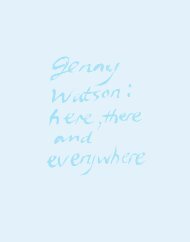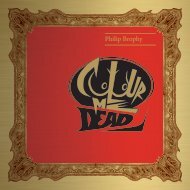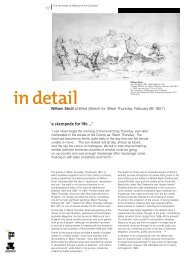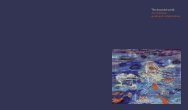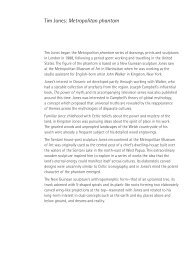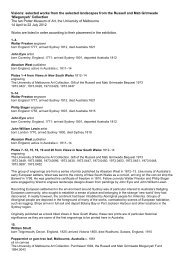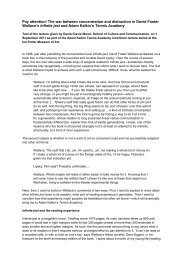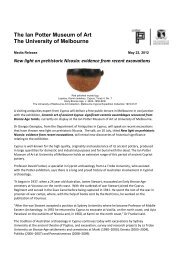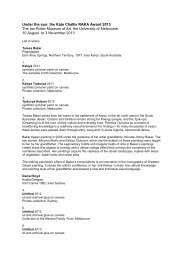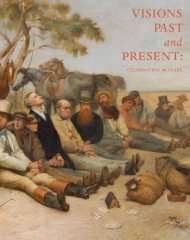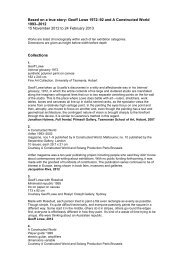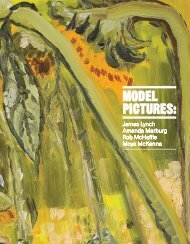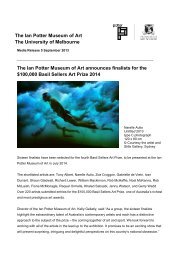Vivienne Shark LeWitt comedies & proverbs
Vivienne Shark LeWitt: comedies & proverbs - Ian Potter Museum of ...
Vivienne Shark LeWitt: comedies & proverbs - Ian Potter Museum of ...
Create successful ePaper yourself
Turn your PDF publications into a flip-book with our unique Google optimized e-Paper software.
Comedies & <strong>proverbs</strong>, installed over three gallery spaces, is<br />
an opportunity to reflect on <strong>Shark</strong> <strong>LeWitt</strong>’s art. Hers is an<br />
independent practice of making paintings in response<br />
to images that appear to her as translations of particular<br />
feelings or moments. This is the imagery of introspection,<br />
self-reflection and empathy for others. <strong>Shark</strong> <strong>LeWitt</strong><br />
communicates these closely held senses of human<br />
circumstance with unusual accuracy, a precision in part<br />
accountable to interpretative painterly methods that have<br />
remained inquisitive and open to experiment. Throughout<br />
the oeuvre, as a result of this exactitude, transactions<br />
between human and sometimes animal figures and their<br />
immediate world are rendered symbolic. The making of Leopold,<br />
a very early painting installed in the upstairs gallery is<br />
typically intoxicating in its obscurity. Flatly painted on two<br />
solid but tiny raw-edged wood panels, the work transgresses<br />
its diptych format with horizon lines and land masses that<br />
don’t meet or match. In a hot Mediterranean landscape,<br />
a stylishly outfitted couple, their hands and faces selfconsciously<br />
drawn, tender and endearing, are held together<br />
in an inexplicable altercation. The couple, their two-wheeler<br />
pram precariously positioned on the left-hand panel, and<br />
a slightly spooky black-sailed boat on the distant horizon<br />
above, could be unrelated were it not for the painting’s<br />
confined format. The male and female figures exchange<br />
flashing looks but their gestures are frozen. The scenery too<br />
appears disconnected: in parts dreamy in mottled orangebrown<br />
but also nakedly sectional. It is as though three or four<br />
portentous moments across time, across different centuries,<br />
have been brought together for re-telling in this painting;<br />
there are no superfluous elements.<br />
<strong>Shark</strong> <strong>LeWitt</strong> is not a prolific artist. Unlike many artists of her<br />
generation, her oeuvre is not marked by distinct phases or<br />
by repetition. As well, there are no discrete series that might<br />
offer a schematic framework for the selection process. Rather<br />
it is typical of the artist to move forward and backward<br />
to earlier motifs as well as re-form or evolve new images.<br />
Bearing this in mind, the exhibition has been distributed<br />
organisationally around four main thematic groupings<br />
that range across the oeuvre with the aim of offering a clear<br />
appreciation of the art’s pictorial and thematic developments.<br />
The first of these organisational groupings comprises the<br />
allegorical paintings of the 1980s; these are installed in the<br />
more intimate space of the upstairs gallery. The second<br />
grouping is ‘transactional/relational’ paintings, the third<br />
grouping includes paintings I think of as ‘negotiating the<br />
outside’, and the last comprises paintings showing a single<br />
female figure.<br />
The first allegorical group includes signature works of the<br />
period such as Last night I dreamed I went to Manderlay again<br />
(1985) and The omen, ‘That wascally wabbit’ (1987, held by<br />
the Art Gallery of New South Wales). These clearly show<br />
<strong>Shark</strong> <strong>LeWitt</strong>’s foundational ‘respect for the past, ancient<br />
to modern, the classic, the romantic, the Gothic, the<br />
symbolic, the iconic—in both culture and nature’. 1 These<br />
early paintings are also the most materially experimental or<br />
adventurous of the exhibition and include all but one of the<br />
eleven made on wood panels. Since 1987, <strong>Shark</strong> <strong>LeWitt</strong> has<br />
painted almost solely on canvas, increasing the scale of the<br />
work, but she still moves easily between oil and acrylic.<br />
In the first half of the 1980s, <strong>Vivienne</strong> <strong>Shark</strong> <strong>LeWitt</strong>, then in<br />
her mid-twenties, exhibited works in important Australian<br />
and international exhibitions including Bernice Murphy’s<br />
1983 Perspecta, Australian visions at the Solomon R Guggenheim<br />
Museum, New York, and Meaning & excellence, ANZART in<br />
Edinburgh (with Lyndal Jones, Howard Arkley, Robert Rooney,<br />
John Lethbridge, Linda Marrinon, Peter Tyndall and Geoff<br />
Lowe). The works exhibited in these exhibitions display both<br />
personal and theoretical interests and, as well as being of<br />
rougher means, are less romantic than the work that was to<br />
follow soon afterwards.<br />
<strong>Shark</strong> <strong>LeWitt</strong>’s close friend and champion, Paul Taylor’s<br />
selection of Charles Meryon the voyeur 1827–1868. La belle et<br />
la bête (1983) to headline his article ‘Civilization and its<br />
discontents’ in the January 1985 issue of Flash Art, confirms<br />
<strong>Shark</strong> <strong>LeWitt</strong>’s own sense that her work was ‘all very public<br />
from the beginning’. It’s worth noting that <strong>Shark</strong> <strong>LeWitt</strong>’s<br />
paintings of the time lacked one or more of the characteristics<br />
of ambitious scale, prolificacy or simple bravado we now<br />
assume to exist in the work of young art-school graduates<br />
that quickly enters the public domain—and it was not so<br />
different then. But more importantly, her success at the time<br />
was to do with the simple fact that the style and content of<br />
5



